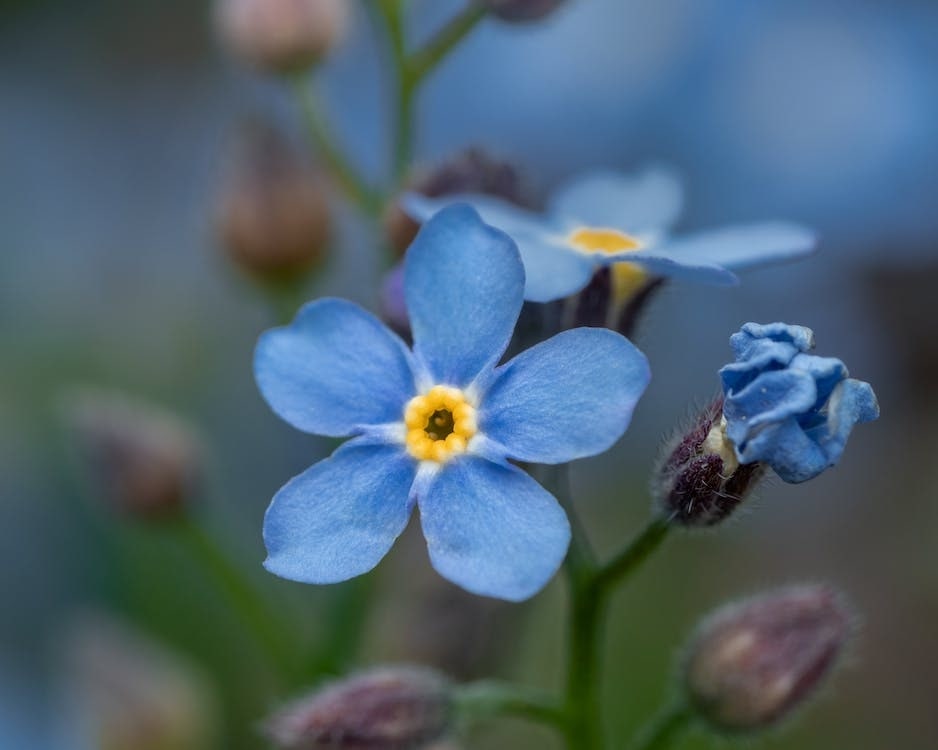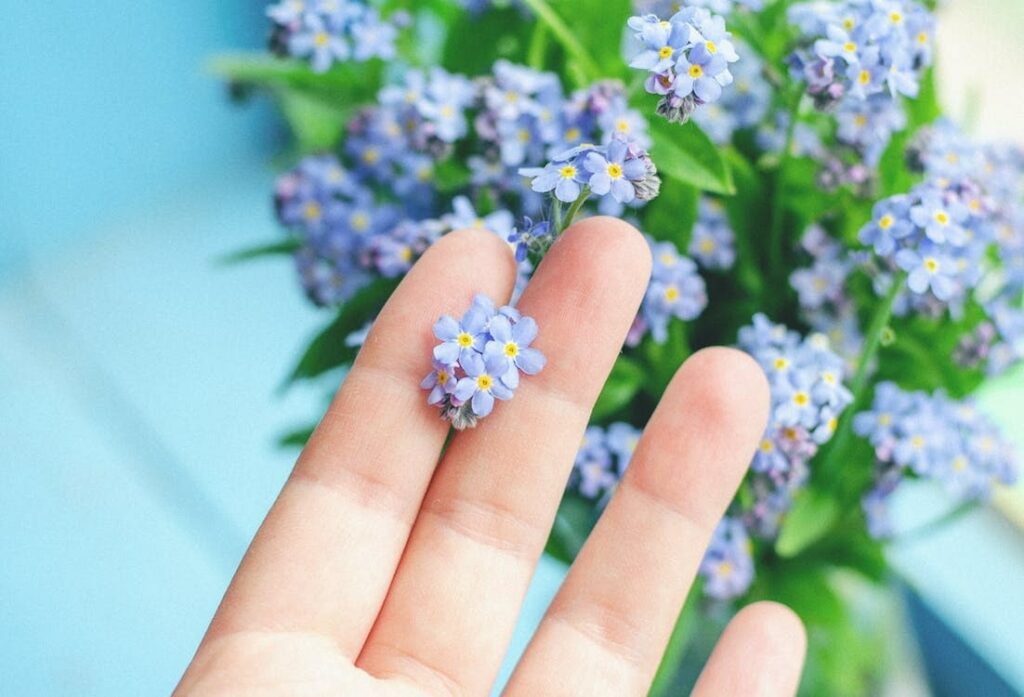The forget-me-not flower is a powerful symbol of love signifying that those who wear it will never be forgotten by their lover.
But how did it come to stand for this idea? And does it have more meanings aside from it?
Actually, yes: there’s more to this flower than most people know. It even has significance in terms of culture, culinary delights, and traditional herbology—which we’ll explore below!
How did the forget-me-not Flower get its name?
The forget-me-not flower got its name from a romantic German legend. The story goes that two lovers were separated by one’s tragic death in a river, with the drowning lover’s last words to the surviving one being “Forget me not!”


The full story starts with the pair, a lady and a knight, walking down the Danube River. There, they come across bright blue blossoms along the riverbank.
Full of love for his lady and wishing to please her, the knight goes to retrieve some of the flowers for the woman.
However, the river’s raging current overpowers him when he steps far into the water. The knight is eventually swept away, leaving his damsel behind.
With his last breath, he tells her, “Forget me not!”
Thus, the flower’s name was born.
Why are forget-me-nots also called myosotis?
Forget-me-nots are also called myosotis because of the oval shape and furry texture of their leaves. Likening them to mice’s ears, people took to calling the plant “myosotis,” which is Greek for “mouse ear.”
Forget-me-not plants are also known as Scorpion Grasses because of their bent stalks, which closely mimic a scorpion’s sting. However, this is arguably the least popular name for them.
What are the botanical origins of the forget-me-not flower?


The botanical origins of forget-me-nots place them in the Myosotis genus of flowering plants under the family Boraginaceae (Borage family). This genus contains approximately 200 species with a wide range of variation.
While these blooms can be found in a variety of colors ranging from pink to white to orange, they’re most commonly associated with the bluish/purple hue.
This is the species called Myosotis sylvatica and is often what people think of when forget-me-nots are mentioned.
When and where do forget-me-not flowers grow?
While forget-me-nots have near-worldwide distribution now, the majority of myosotis are found in Eurasia or New Zealand, though quite a few varieties can also be found in North and South America.
They also tend to grow most in the spring to summer seasons.
Because they are generally easy to grow and don’t require much sun, these flowering plants are popular and common garden flowers.
If you want to grow them yourself, here are some common questions and answers about their environmental preferences and care:
Do forget-me-nots require a lot of maintenance?
No, forget-me-nots don’t require a lot of maintenance.
Do forget-me-nots need shade or sun?
Although forget-me-nots prefer shade, they will also thrive in partial shade and full sun.
Where do forget-me-nots bloom?
Forget-me-nots bloom profusely in shady areas.
When do forget-me-nots bloom?
Forget-me-nots’ peak blooming season is from April to May in most climates, and it lasts until summer.
What kind of soil do forget-me-nots prefer?
Forget-me-nots prefer loamy, sandy, or clay soil and can tolerate just about any pH balance. The soil should be kept moist even if it’s well-drained.
When is the best time to plant forget-me-not seeds?
The best time to plant forget-me-not seeds is from spring to August if you want to have blooms the following spring.
What do forget-me-not flowers mean?
Forget-me-nots’ harmless, thornless nature suggests deference as well. Beyond this, the flowers also have cultural symbolism in various parts of the world.
What do the colors and symbolisms of the forget-me-not flower mean?
Each of the forget-me-not’s colors has a different symbolism. Each color can communicate a different form of affection, with blue meaning “remembrance” and white meaning “purity,” for example.


What is the cultural significance of the forget-me-not flower?
The forget-me-not flower has a cultural significance that varies based on the context.
For instance, it once served as an emblem of the English court, a symbol of remembrance after death (and hence, appeared in funeral arrangements), and decoration at weddings.
The different meanings assigned to it are from different periods of history, cultures, and religions. Depending on these contexts, the myosotis carries a different purpose and representation.
What did the myosotis symbolize in various historical periods?
As mentioned earlier, the myosotis has symbolized many things. Below, we’ll go through just a few of the things it has stood for at different points in history for the West in particular.


What are the cultural associations of the forget-me-not flower?
The forget-me-not flower has had various cultural associations all over the world, but in general, it is most often linked to weddings, fidelity, and the concept of love and marital bonds, both in eastern and western cultures.
As we’ve already discussed, it has long been associated with remembrance and romance in Europe. Below are some other examples of cultural associations for it in other countries.


What are the spiritual or religious meanings of the forget-me-not flower?
The spiritual meaning of the forget-me-not flower often revolves around remembrance, devotion, and respect.
To Christians, it’s associated with the Virgin Mary; to Buddhists, it’s a reminder of Buddha’s teachings; and to the Hindus, it’s a symbol of fortune and wealth.


Other Significant Symbolisms of Forget-me-nots
Forget-me-nots are still used as a modern symbol of remembrance and grief following a loss. Here are some other interesting ways the forget-me-not has been used as a symbol relating to these ideas:
- It is the official flower of the Armenian Genocide.
- It is used as an awareness-raising symbol for memory loss by the Alzheimer’s Association.
- It’s the flower associated with Grandparent’s Day.
- It’s been used to represent women who have had a miscarriage or stillbirth. The flower symbolizes how bereaved mothers never forget their lost children.
What are the uses of the forget-me-not flower?
Forget-me-not flowers can be used for various purposes other than as a gift or decor. In fact, they can even be used as a medicinal agent or as a garnish for a meal.


How can the forget-me-not flower be used in cooking?
Ornamental forget-me-nots can be used as ingredients or garnishes in cooking because they’re edible.
If you’re sure that no pesticides have been used, you can use a forget-me-not flower to add nice color to baked goods and make excellent candied blossoms. The small flower can be frozen in an ice cube or used to decorate a cupcake.
The flower can also be used as a garnish and flavor enhancer in soups and salads. Forget-me-not flowers have a light, grassy flavor.
Can the forget-me-not flower be used as medicine?
The forget-me-not flower can be used as medicine, or more specifically, as an herbal remedy. However, taking it on a regular basis is not advised since more research is needed to validate all of the plant’s alleged medical benefits.
Despite safety concerns, extracts from the roots, barks, and flowers forget-me-not are often used to treat lung problems and nosebleeds. Unfortunately, more scientific evidence is required to confirm this benefit.
In rural areas, some people use myosotis to treat eye infections and other ailments. The whole plant itself is ophthalmic and is believed that when the extract is used as a lotion (externally), it can remedy many eye diseases.
Indeed, the flower is said to treat certain eye diseases in the pseudoscience doctrine of signatures (DOS), as its petals and center resemble an eye—with a blue iris and a pupil.
DOS implies that the appearance of a plant can reveal its medicinal benefits. However, this alleged health benefit has not been scientifically proven either.


How can the forget-me-not flower be used in gardening?
The forget-me-not can be used in gardening as ground cover or as a border plant. This is because it grows low to the ground, which means it can decorate your garden while preventing soil erosion and unwanted weeds.
Many small myosotis can bloom beautifully as potted porch plants as well, so they do not even need to be planted in the ground.



